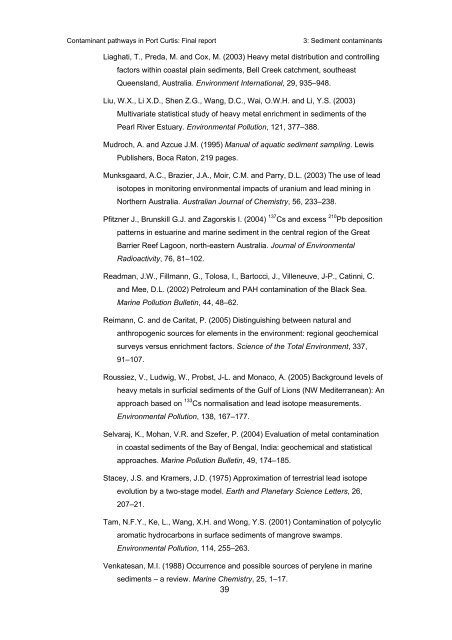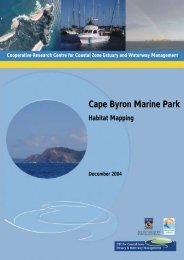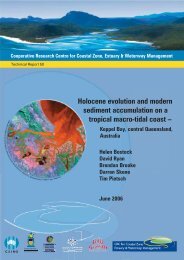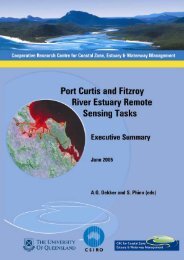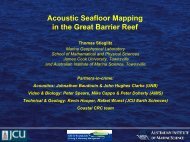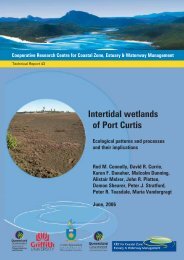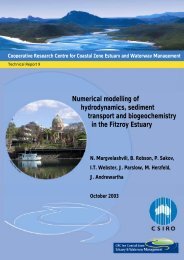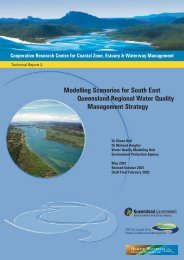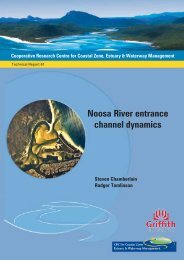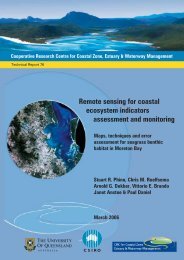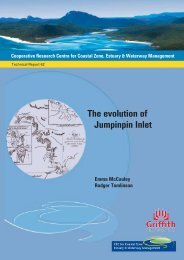Contaminant pathways in Port Curtis: Final report - OzCoasts
Contaminant pathways in Port Curtis: Final report - OzCoasts
Contaminant pathways in Port Curtis: Final report - OzCoasts
Create successful ePaper yourself
Turn your PDF publications into a flip-book with our unique Google optimized e-Paper software.
<strong>Contam<strong>in</strong>ant</strong> <strong>pathways</strong> <strong>in</strong> <strong>Port</strong> <strong>Curtis</strong>: F<strong>in</strong>al <strong>report</strong>3: Sediment contam<strong>in</strong>antsLiaghati, T., Preda, M. and Cox, M. (2003) Heavy metal distribution and controll<strong>in</strong>gfactors with<strong>in</strong> coastal pla<strong>in</strong> sediments, Bell Creek catchment, southeastQueensland, Australia. Environment International, 29, 935–948.Liu, W.X., Li X.D., Shen Z.G., Wang, D.C., Wai, O.W.H. and Li, Y.S. (2003)Multivariate statistical study of heavy metal enrichment <strong>in</strong> sediments of thePearl River Estuary. Environmental Pollution, 121, 377–388.Mudroch, A. and Azcue J.M. (1995) Manual of aquatic sediment sampl<strong>in</strong>g. LewisPublishers, Boca Raton, 219 pages.Munksgaard, A.C., Brazier, J.A., Moir, C.M. and Parry, D.L. (2003) The use of leadisotopes <strong>in</strong> monitor<strong>in</strong>g environmental impacts of uranium and lead m<strong>in</strong><strong>in</strong>g <strong>in</strong>Northern Australia. Australian Journal of Chemistry, 56, 233–238.Pfitzner J., Brunskill G.J. and Zagorskis I. (2004) 137 Cs and excess 210 Pb depositionpatterns <strong>in</strong> estuar<strong>in</strong>e and mar<strong>in</strong>e sediment <strong>in</strong> the central region of the GreatBarrier Reef Lagoon, north-eastern Australia. Journal of EnvironmentalRadioactivity, 76, 81–102.Readman, J.W., Fillmann, G., Tolosa, I., Bartocci, J., Villeneuve, J-P., Cat<strong>in</strong>ni, C.and Mee, D.L. (2002) Petroleum and PAH contam<strong>in</strong>ation of the Black Sea.Mar<strong>in</strong>e Pollution Bullet<strong>in</strong>, 44, 48–62.Reimann, C. and de Caritat, P. (2005) Dist<strong>in</strong>guish<strong>in</strong>g between natural andanthropogenic sources for elements <strong>in</strong> the environment: regional geochemicalsurveys versus enrichment factors. Science of the Total Environment, 337,91–107.Roussiez, V., Ludwig, W., Probst, J-L. and Monaco, A. (2005) Background levels ofheavy metals <strong>in</strong> surficial sediments of the Gulf of Lions (NW Mediterranean): Anapproach based on 133 Cs normalisation and lead isotope measurements.Environmental Pollution, 138, 167–177.Selvaraj, K., Mohan, V.R. and Szefer, P. (2004) Evaluation of metal contam<strong>in</strong>ation<strong>in</strong> coastal sediments of the Bay of Bengal, India: geochemical and statisticalapproaches. Mar<strong>in</strong>e Pollution Bullet<strong>in</strong>, 49, 174–185.Stacey, J.S. and Kramers, J.D. (1975) Approximation of terrestrial lead isotopeevolution by a two-stage model. Earth and Planetary Science Letters, 26,207–21.Tam, N.F.Y., Ke, L., Wang, X.H. and Wong, Y.S. (2001) Contam<strong>in</strong>ation of polycylicaromatic hydrocarbons <strong>in</strong> surface sediments of mangrove swamps.Environmental Pollution, 114, 255–263.Venkatesan, M.I. (1988) Occurrence and possible sources of perylene <strong>in</strong> mar<strong>in</strong>esediments – a review. Mar<strong>in</strong>e Chemistry, 25, 1–17.39


